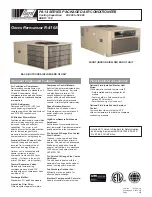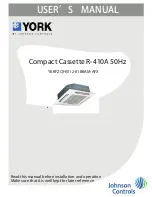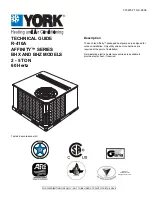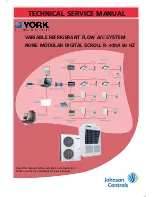
70
Rooftop Dedicated Outdoor
Air System Installation Manual
Due to our policy of continuous product innovation, some specifications may change without notification.
©LG Electronics U.S.A., Inc., Englewood Cliffs, NJ. All rights reserved. “LG” is a registered trademark of LG Corp.
Furnace Staging
Furnaces are staged to maintain the supply temperature set-point. Furnaces stage in a fixed order based on factory installation:
Modulating Furnace:
The modulating signal tracks the heating ramp of the controller.
Fixed Stage Furnace: The heating ramp of the controller stages furnaces as needed.
Circuit Pressure Control
Condenser fans or water valves modulate to maintain the saturated gas temperature set-point.
Set-points: The circuits can be controlled to three different set-points: heating, cooling, and dehumidification.
Condenser Fan Staging: Condenser fans stage to maintain the active circuit pressure control set-point.
•
Modulating Fans: Modulating fans are ramped with the circuit pressure control ramp. If a unit has both modulating and fixed capacity fans,
the modulating fan is used to trim capacity between stages of fixed fans.
• Fixed Fans: Fixed fans are staged on when more capacity is needed than the modulating fan is capable of providing and staged off when
the modulating fan is at its minimum speed.
Water Source Heat Pump Head Pressure Control: Circuit pressure control in a water source heat pump consists of one or two water valves
and a coaxial heat exchanger. The water valves modulate to maintain the active circuit pressure control setpoint in cooling, dehumidification,
and heating modes.
Compressor Envelope Control
Compressor envelope control is available for all units but is dependent on hardware installed. The operating envelope is comprised of mini-
mum and maximum evaporating and condensing temperatures that create an envelope of desired operating limits based on the compressor
manufacturer’s limitations.
Units Without Electronic Expansion Valves: If any of the following alarm conditions occur, the modulating capacity of the compressor is
reduced or the fixed stage compressor is turned off. These alarm conditions can be disabled by disabling compressor envelope alarms:
• High Saturated Discharge Temperature: A high saturated discharge temperature alarm activates if the saturated discharge temperature
rises above the alarm set-point.
• Low Saturated Suction Temperature: A low saturated suction temperature alarm activates if the saturated suction temperature falls below
the alarm set-point for a delay.
• High Discharge Line Temperature: If the discharge line temperature rises above the alarm set-point for the duration of the compressor
protection delay, a high discharge line temperature alarm activates.
• High Superheat: If the superheat rises above the alarm set-point for the duration of the compressor protection delay, a high superheat alarm
activates.
• High Compression: Based on sliding pressure ranges and the difference between suction and discharge refrigerant pressures, if the differ-
ence rises above a calculated set-point for the compressor protection delay, a high compression ratio alarm activates. This alarm remains
active after the alarm condition clears for the duration of the envelope alarm lockout delay or until the alarm is manually reset.
• High Suction: If the suction pressure rises above the alarm set-point for the duration of the envelope alarm protection delay, a high suction
pressure alarm activates. This alarm remains active after the alarm condition clears for the duration of the envelope alarm lockout delay or
until the alarm is manually reset.
CONTROLLER
Sequences of Operation
















































